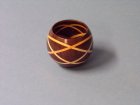I’ve been watching some videos of segmented turning.
I’ve noticed that a lot of guys are using some sort of “black paper” between each segment in which looks really sharp.
What is this paper type material?
I’ve noticed that a lot of guys are using some sort of “black paper” between each segment in which looks really sharp.
What is this paper type material?

